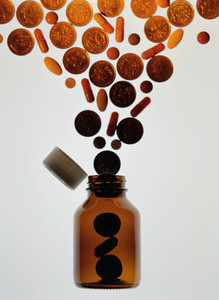A US-based retrospective cohort study has found that generics prices increase when competition is low or non-existent [1].
Generics prices increase when competition decreases
Generics/Research
|
Posted 11/08/2017
 0
Post your comment
0
Post your comment

Generics prices have been highlighted recently after some old generics experienced dramatic price increases. For example, the price of digoxin, a medication used to treat congestive heart failure, increased from US$0.12 a pill in July 2013 to US$1.06 a pill in June 2014 [2]. Then in August 2015, Turing Pharmaceuticals (Turing) increased the price of its newly acquired 62-year-old infectious disease drug Daraprim (pyrimethamine) from US$13.50 a tablet to US$750 – a 5,000% price hike [3]. Different reasons have been proposed to explain these price increases. One of which is that a reduction in the number of manufacturers of a drug can result in insufficient competition.
In order to investigate the influence of reduced competition, investigators from the University of Florida, Brigham and Women’s Hospital and the University of Utah studied prescription drug claims from commercial health plans between 2008 and 2013. The aim of the study was to determine the association between market competition levels and changes in generics prices in the US.
The authors divided the 5.5 years of data into 11 study periods of 6 months each. They then calculated the Herfindahl–Hirschman Index (HHI)* and average generics prices for each period. The HHI gives an indication of market competition, with a higher HHI value indicating a less competitive market.
The investigators identified a cohort of 1,120 generics from 1.08 billion prescription claims. The results showed that drugs with a quadropoly, or relatively high levels of competition (HHI value of 2,500), were associated with a 31.7% (95% CI: −34.4% to −28.9%) reduction in price. This compared to drugs with a duopoly (HHI value of 5,000), which experienced only an 11.8% (CI: −18.6% to −4.4%) reduction in price. However, in stark contrast, drugs with a near-monopoly (HHI value of 80,00) were associated with a price increase of 20.1% (CI: 5.5% to 36.6%) and drugs with a monopoly (HHI value of 10,000) had a price increase of 47.4% (CI: 25.4% to 73.2%), over the study period.
The authors concluded that ‘market competition levels were associated with a change in generic drug prices’. Finally, they recommended that ‘such measurements may be helpful in identifying older prescription drugs at higher risk for price change in the future’.
*The Herfindahl-Hirschman Index (HHI) is a commonly accepted measure of market concentration. It is calculated by squaring the market share of each firm competing in a market, and then summing the resulting numbers, and can range from close to zero to 10,000. The US Department of Justice uses the HHI for evaluating potential mergers issues.
Related articles
Policies to address price rises in old generics
US politicians form Affordable Drug Pricing Task Force
References
1. Dave CV, Kesselheim AS, Fox ER, Qiu P, Hartzema A. High generic drug prices and market competition: a retrospective cohort study. Ann Intern Med. 2017. doi:10.7326/M16-1432. [Epub ahead of print]
2. GaBI Online - Generics and Biosimilars Initiative. Generics makers to be penalized for huge price hikes [www.gabionline.net]. Mol, Belgium: Pro Pharma Communications International; [cited 2017 Aug 11]. Available from: www.gabionline.net/Policies-Legislation/Generics-makers-to-be-penalized-for-huge-price-hikes
3. GaBI Online - Generics and Biosimilars Initiative. Senator calls for FTC to investigate drug makers for antitrust violations [www.gabionline.net]. Mol, Belgium: Pro Pharma Communications International; [cited 2017 Aug 11]. Available from: www.gabionline.net/Policies-Legislation/Senator-calls-for-FTC-to-investigate-drugmakers-for-antitrust-violations
Permission granted to reproduce for personal and non-commercial use only. All other reproduction, copy or reprinting of all or part of any ‘Content’ found on this website is strictly prohibited without the prior consent of the publisher. Contact the publisher to obtain permission before redistributing.
Copyright – Unless otherwise stated all contents of this website are © 2017 Pro Pharma Communications International. All Rights Reserved.
Most viewed articles
The best selling biotechnology drugs of 2008: the next biosimilars targets
Global biosimilars guideline development – EGA’s perspective
Related content
Japan’s drug shortage crisis: challenges and policy solutions
Saudi FDA drug approvals and GMP inspections: trend analysis
Generic medications in the Lebanese community: understanding and public perception
Community pharmacists’ understanding of generic and biosimilar drugs: Lebanon case study
Generic medications in the Lebanese community: understanding and public perception

Generics/Research Posted 23/01/2024
Community pharmacists’ understanding of generic and biosimilar drugs: Lebanon case study

Generics/Research Posted 08/09/2023
The best selling biotechnology drugs of 2008: the next biosimilars targets








Post your comment